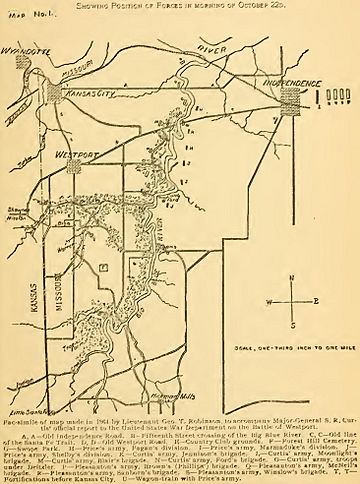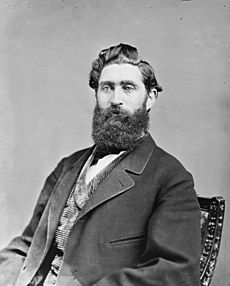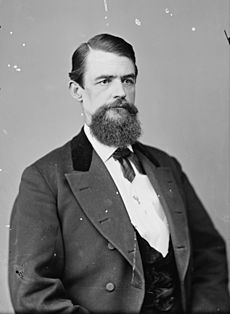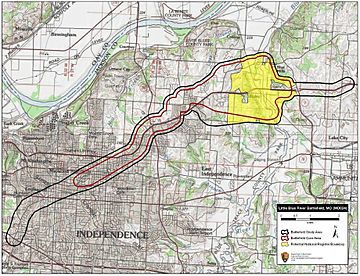Battle of Little Blue River facts for kids
Quick facts for kids Battle of Little Blue River |
|||||||
|---|---|---|---|---|---|---|---|
| Part of Price's Raid during the American Civil War |
|||||||
 Brigadier General Joseph O. Shelby was a key Confederate commander at Little Blue River |
|||||||
|
|||||||
| Belligerents | |||||||
| Commanders and leaders | |||||||
| Samuel R. Curtis James G. Blunt Thomas Moonlight |
Joseph O. Shelby M. Jeff Thompson Colton Greene |
||||||
| Strength | |||||||
| 2,800 | 5,500 | ||||||
| Casualties and losses | |||||||
| At least 20 | At least 34 | ||||||
The Battle of Little Blue River happened on October 21, 1864. It was part of a big attack called Price's Raid during the American Civil War.
Major General Sterling Price led a Confederate army into Missouri in September 1864. He hoped to take control of the state from the Union. Price first planned to capture St. Louis, but changed his mind. Then he aimed for Jefferson City, but it was too strong. So, the Confederates moved west. They pushed back a Union force led by Major General James G. Blunt at the Second Battle of Lexington on October 19.
Two days later, Blunt left some of his soldiers with Colonel Thomas Moonlight. Their job was to hold the crossing at the Little Blue River. The rest of Blunt's force went back to Independence. On the morning of October 21, Confederate troops attacked Moonlight's line. Parts of Brigadier General John B. Clark Jr.'s group managed to cross the river. Both sides attacked and counterattacked, but neither gained a clear lead.
Blunt got permission to fight at the Little Blue River. He and Major General Samuel R. Curtis returned with more soldiers. This brought the Union's total strength to about 2,800 men. More Confederate soldiers arrived, making their total about 5,500. One Confederate cavalry group tried to attack the Union's side. Another Confederate group pushed the Union's middle line. The Union soldiers had to fall back. The main fighting stopped around 4:00 PM when Union troops reached Independence. They later retreated further to the Big Blue River, leaving Independence behind.
The next day, Union soldiers retook Independence. On October 23, the Confederates were defeated at the Battle of Westport. This forced Price's army to leave Missouri.
Contents
Why the Battle Happened: Missouri in the Civil War
At the start of the American Civil War in 1861, Missouri was a slave state. But it did not officially leave the United States. The state was divided. The governor and the Missouri State Guard supported the Confederate States of America. However, Union forces led by Brigadier General Nathaniel Lyon stayed loyal to the United States.
Confederate forces won some early battles in Missouri. But by the end of 1861, Union troops pushed them back. In 1862, a Confederate loss in Arkansas gave the Union control of Missouri. After that, most fighting in Missouri was small guerrilla attacks.
By September 1864, the Confederacy was losing the war. Confederate leaders wanted to do something big to help their side. General Edmund Kirby Smith decided to attack Missouri. He hoped this would make the Union send troops away from other important battles. Sterling Price was chosen to lead this attack. Price also hoped that people in Missouri would rise up against Union control. He thought this would help end the war.
On September 19, Price's army, called the Army of Missouri, entered the state. It had three main groups, led by Major General James F. Fagan and Brigadier Generals John S. Marmaduke and Joseph O. Shelby.
Before the Fight: Price's Raid Begins
Price's army had about 13,000 cavalry soldiers. But many of them were not well-armed. The Union had fewer than 10,000 soldiers in Missouri. Many of these were local militia groups. Some were well-trained, but others were not ready for big battles.
In late September, Price's army attacked Fort Davidson at Pilot Knob. The attack failed, but the Union soldiers left the fort that night. Price lost many men there. He then decided not to attack St. Louis. Instead, he aimed for Jefferson City. Price's army moved slowly because they had many wagons. This gave the Union time to send more soldiers to Jefferson City. Price saw that Jefferson City was too strong to attack. So, he began moving west along the Missouri River. His army gathered new soldiers and supplies along the way.
Meanwhile, Union troops from Kansas were called to fight Price. Major General James G. Blunt gathered Union soldiers and Kansas militia. These troops formed a new group called the Army of the Border. It was led by Major General Samuel R. Curtis.
On October 18, Blunt's advance group reached Lexington. They hoped to trap Price's army. But Price was too close, and Blunt did not get enough help from other Union forces. So, Blunt decided to defend his position. On October 19, Confederate soldiers attacked Lexington. Blunt's troops held their ground for a while. But they had to retreat when Price brought in more of his army.
The Battle: Fighting at Little Blue River
Moonlight's Stand at the River
After the fight at Lexington, Blunt's forces moved west. Colonel Moonlight's group stayed behind to protect the retreat. On the morning of October 20, Blunt wanted to defend a spot east of the Little Blue River. But he was ordered to leave a small force there and fall back to the Big Blue River.
Blunt left the 11th Kansas Cavalry Regiment and four cannons with Moonlight. This force had about 400 to 600 men. They were told to burn the bridge over the river when the Confederates arrived. Other small groups guarded river crossings. But some crossings closer to the bridge were left open. The river was also shallow in many places, making it easy to cross.
Confederate soldiers attacked around 7:00 AM on October 21. They fought hard with Union soldiers. The Union defenders at the bridge set it on fire. Meanwhile, Confederate groups found other ways to cross the river. One Union group was surrounded and had to retreat. More Confederate soldiers crossed the river, but it was slow because of the crowds.
The Union soldiers at the burning bridge also retreated. But the Confederates put out the fire, so the bridge could still be used. The 11th Kansas Cavalry moved to a hilltop with a stone wall. Moonlight's four cannons were set up there. Confederate soldiers attacked uphill but were pushed back by the Kansans' fast-firing rifles.
More Confederate soldiers and cannons arrived. The 11th Kansas Cavalry attacked back. The fighting was very close. The Confederate cannons could not fire because they might hit their own men. They fired empty shots to trick the Union soldiers. The Kansans retreated, thinking they were under heavy fire. Both sides kept attacking and counterattacking, but neither side gained a clear win.
Blunt and Curtis Arrive
Meanwhile, General Blunt got permission to fight at the Little Blue River. He returned from Independence with more soldiers and cannons. This added about 900 men to the Union side. By 11:00 AM, Moonlight's force had fallen back about two miles from the river.
With Blunt's arrival, the Union had about 2,600 men and 15 cannons. Confederate forces from two divisions were also there, totaling about 5,500 men. Even though the Union had fewer soldiers, they had better firepower. The Union soldiers fought without their horses. About a quarter of them were sent to the back to hold the horses.
The increased Union numbers put pressure on the Confederates. Some Confederates ran low on ammunition and started to retreat. But more Confederate groups arrived to help. Then, Brigadier General M. Jeff Thompson's group crossed the river and joined the fight. General Shelby ordered a full attack on the Union line.
General Curtis arrived around 1:00 PM with two more cannons. The Union now had about 2,800 soldiers. Curtis saw a Confederate group trying to get around the Union's side. He sent cannons to stop them. But this made the middle of the Union line weaker.
Shelby saw the weak Union center and pushed his attack harder. Union soldiers started to run low on ammunition. With Confederates attacking their side and middle, the Union troops began to retreat. Blunt put Colonel James H. Ford in charge of protecting the retreat. The Union soldiers fought as they fell back, with one line fighting while the other moved back.
During the retreat, some Union cannons got stuck. But other Union soldiers bravely charged to save them. The Union soldiers made a stand on a ridge near Independence. But this position was not safe, and they left it around 3:00 PM. The Confederates were disorganized, so Blunt used the break in fighting to form a line at Independence. By 4:00 PM, the main fighting had stopped.
The Union soldiers retreated about seven miles to Independence. Later that afternoon, Blunt ordered a retreat to the Big Blue River. Some small fights happened in Independence itself. By nightfall, Union soldiers were west of the Big Blue River, and Price's army was in the Independence area.
What Happened Next and Preserving the Battlefield
The battle had some casualties. The Union's 11th and 15th Kansas Cavalries and 2nd Colorado Cavalry lost 20 men killed. On the Confederate side, the 3rd Missouri Cavalry Regiment had 31 killed or wounded. A famous Confederate guerrilla leader, George Todd, was also killed.
The day after the battle, Price sent General Shelby's men to attack the Union line at the Big Blue River. Shelby's men crossed the river, forcing the Union to retreat again. Meanwhile, other Union soldiers attacked Price's army from the east. They retook Independence.
On October 23, Price's army fought the Battle of Westport. They were defeated by the Union forces. This forced Price's men to retreat from Missouri. They traveled through Kansas and Arkansas, losing many more battles and soldiers. Price lost over two-thirds of his men during the entire campaign.
A study in 2011 looked at the Little Blue River battlefield. It found that the land was broken up, but could still be saved. The study also noted that new roads threatened the site. The battlefield is not yet a national historic place. But a large part of it could be.
Today, there are signs and a driving tour at the battlefield. This helps people learn about the battle.
Images for kids
See also
 In Spanish: Batalla de Little Blue para niños
In Spanish: Batalla de Little Blue para niños












